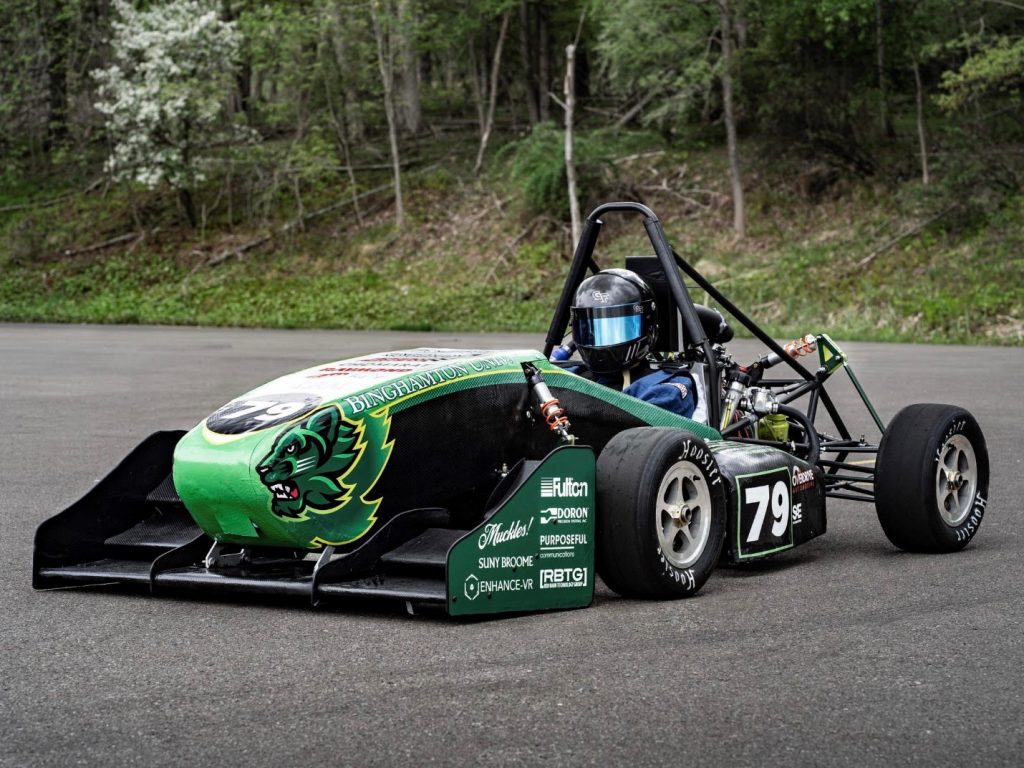Binghamton Motorsports (BingMotorsports) has gone electric.
BingMotorsports, a club and collegiate team that falls under the Binghamton University chapter of the Society of Automotive Engineers (SAE), is attempting to build an electric vehicle for the first time since their founding in 2017. The project is scheduled to be finished during this upcoming spring semester, making the project a yearlong effort. All steps that go into making the vehicle — recruiting the team, making the designs, manufacturing and ordering the components and testing the vehicle — are accomplished by the club’s over 70 student members.
Leslie Torres, project manager for the Binghamton Formula SAE team and a senior majoring in electrical engineering, wrote that the initiative started as a smaller engineering project between her and her two friends, wanting to “electrify” an old chassis. According to Torres, they decided to turn it into a Binghamton Formula SAE team project because electric vehicle manufacturing had been previously mentioned during club meetings and fit with their future plans.
“We thought it would be a great new challenge for our engineers and align with new focuses on sustainability and Binghamton’s battery development research,” Torres wrote in an email.
According to Torres, the beginning steps in bringing the electric car to fruition is recruitment, which for engineers, takes place in the spring. Each subteam will then learn about the fundamentals of vehicle dynamics and the key components of their system. The design phase follows, which includes sketching out the suspension geometry, as well as the Computer-Aided Design, for their chassis and drivetrain system. The electrical team and the accumulator team develop the designs for their respective parts.
Next comes manufacturing and ordering components for the project, starting late fall and continuing through the winter, which includes the involvement of the chassis team, drivetrain team, suspension team, electrical team and aerodynamics team. Torres said the testing phase is the last part of the development process, spanning from early spring until June. Once the rolling chassis is completed and all the components are mounted onto the vehicle, testing will be performed as often as possible, Torres explained.
“As engineers it’s critical that we acquire data to validate our designs,” Torres wrote. “This means running drive days, collecting information about performance and tuning the vehicle to perfection. After months of hard work, our final step is going to the competition.”
Torres shared that one of the challenges of the project is keeping up with the one-year time limit. There are many requirements the team has to pass — which is time-consuming, as the rule book is 130 pages long. Torres said it is difficult for team members to juggle taking classes and maintaining a life outside of the shop.
Jason Tang, tractive system lead and a senior majoring in electrical engineering, said he finds working on the project to be a great opportunity. Being involved with the design and creation of an electrical powertrain as an electrical engineering major is significant, Tang felt, particularly compared to past years.
“In prior years, the electronics teams were rather immature with the extent of their knowledge because Formula has traditionally been dominated by mechanical engineers and car enthusiasts prior, without a significant workload for electrical engineers involved,” Tang wrote.
Joe Green, president of SAE and a junior majoring in mechanical engineering, said the transition toward electric vehicles is significant because it matches the trends of the world and BU.
“The world is moving toward electrification, and that already includes BU with expenditures on the order of millions for R&D in fields like renewables, energy storage, etc.,” Green wrote in an email. “It makes sense for us to jump in now.”
Following finals, the team will participate in Formula SAE, an international competition. After arriving and setting up their paddock, the team’s week will consist of technical inspections, design events and dynamic events.
According to Torres, all of the hard work is worth it in the end — when when the team sees the finished product.
“There is no better feeling than seeing the car drive for the first time in the spring,” Torres said. “After such a grind, it’s incredibly surreal to see the product that a committed group of students can produce. It gives us the energy to come back and do it again year after year. We really wouldn’t have it any other way.”



